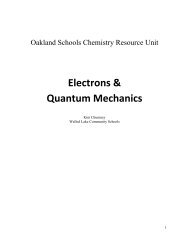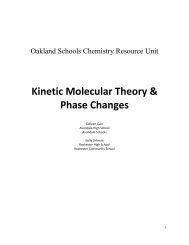Nomenclature and Chemical Reactions - Oakland Schools
Nomenclature and Chemical Reactions - Oakland Schools
Nomenclature and Chemical Reactions - Oakland Schools
You also want an ePaper? Increase the reach of your titles
YUMPU automatically turns print PDFs into web optimized ePapers that Google loves.
Safety Concerns<br />
Students must wear goggles <strong>and</strong> aprons at all times.<br />
Station 1: DO NOT look directly at the burning magnesium – it can damage your<br />
eyes<br />
Station 2: Silver nitrate can stain skin <strong>and</strong> clothing.<br />
Station 3: Hydrochloric acid is corrosive to skin, use caution. Have baking soda<br />
available to neutralize spills.<br />
Station 4: Copper (II) sulfate is a skin irritant.<br />
Station 5: None, but see disposal note.<br />
Station 6: Don’t get hydrogen peroxide in cuts.<br />
Station 7: MUST BE DONE IN FUME HOOD.<br />
Station 8: Copper (II) sulfate hydrate can be a skin irritant. Do not breathe<br />
fumes while heating.<br />
Station 9: Alcohol burners do get warm. Methanol is very hot <strong>and</strong> burns nearly<br />
invisible. Ethanol burns with a blue flame <strong>and</strong> is safer.<br />
Disposal: Dispose of all substances per MSDS sheet or disposal methods in the<br />
Flinn Scientific <strong>Chemical</strong> Catalog. MSDS sheets <strong>and</strong> safety information can be<br />
found at www.FlinnSci.com .<br />
Real-World Connections<br />
Can relate reactions to the fact that many items (foods, pharmaceuticals) are<br />
made through chemical reactions. Discuss that your body works because of<br />
many chemical processes <strong>and</strong> reactions.<br />
Sources<br />
http://staff.imsa.edu/science/chemistry/web/<strong>Chemical</strong>%20<strong>Reactions</strong>%20Labrevised.pdf<br />
Procedure/Description of Lesson<br />
Students will perform a series of chemical reactions, make observations, <strong>and</strong><br />
balance the equations they performed. Students will identify types of reactions,<br />
parts of an equation, <strong>and</strong> give evidence of a chemical reaction.<br />
See Lab H<strong>and</strong>out below:<br />
30
















